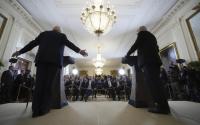12 September 2007John M. Broder
The prospect of a comprehensive energy package’s emerging from Congress this fall is rapidly receding, held up by technical hurdles and policy disputes between the House and the Senate and within the parties.
This summer, both houses passed major bills meant to promote energy efficiency and wean industry from fossil fuels. The bills have gaping differences that are supposed to be resolved in a conference committee.
Democratic leaders in both chambers have signaled that conference committee members are unlikely to be named until late October, at the earliest. Others suggested that leaders may try to resolve the differences in the bills without convening a conference, which would create other problems, including the threat of a Republican filibuster in the Senate.
Although Democratic leaders proclaimed energy a top legislative priority last January, the issue competes with Iraq, appropriations, financial market turmoil and product safety for room on Congress’s fall calendar.
The Senate passed its energy bill on June 21; the House passed its on Aug. 4. The most significant provisions include increasing automobile fuel-efficiency standards to a fleet average of 35 miles per gallon by 2020, compared to 27.5 m.p.g. today.
The standard for light trucks is 20.7 m.p.g.
Another section would require utilities to generate 15 percent of their electricity from renewable sources by 2020.
The mileage standard appears just in the Senate bill, having been squelched in the House by the opposition of Representative John D. Dingell, the powerful Democrat from Michigan. The mandate for renewable power is just in the House bill, having failed in the Senate.
Ordinarily, House and Senate leaders appoint conferees to reconcile bills. But because the Senate and House passed entirely different bills, not simply different versions, one or both chambers will have to pass the other’s bill before it can be “conferenced.”
An aide to Speaker Nancy Pelosi said staff members were working to fashion a Senate bill to match the House version.
Senator Richard J. Durban of Illinois, the chamber’s No. 2 Democrat, said Republicans were threatening to block the appointment of conferees or to amend the bill to eliminate provisions they did not like, including billions of dollars in new taxes on the oil industry.
President Bush has threatened to veto the House bill, which he says does not have enough incentives for domestic energy production, and the Senate bill because it has penalties for price gouging by the oil industry.
“It’s not a pretty picture,” said Frank Maisano, an energy lobbyist. “That’s not to say that in time they won’t be able to craft a compromise. But they’re clearly not in any hurry.”
As Congress moves at its own pace, at least 300 bills have been filed in 40 states this year on energy efficiency, emissions of heat-trapping gases or climate change, the National Conference of State Legislatures says.
Twenty states and the District of Columbia have adopted renewable energy requirements for utilities. California is leading 12 states trying to impose tailpipe emissions standards that will force manufacturers to produce more fuel-efficient cars.
On Wednesday, the National Governors Association announced a clean-energy initiative to speed passage of state measures to increase conservation and biofuel production and to reduce heat-trapping gases.
“This is the defining issue of our time,” said Gov. Tim Pawlenty of Minnesota, a Republican, “and there is great interest and momentum percolating in the states. While we have our problems and our conflicts, we’re relatively less polarized than Congress and thus can be more nimble.”






